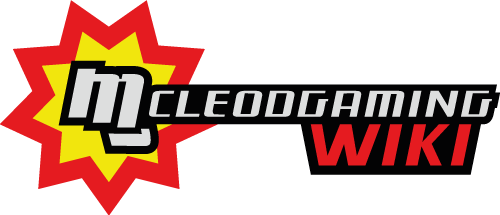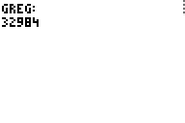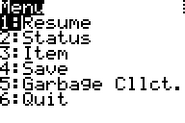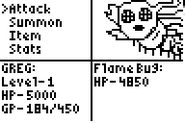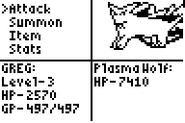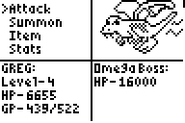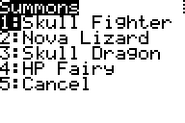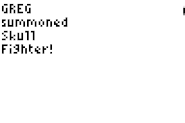Gem of Jharmen 2, fully titled Gem of Jharmen 2: The Lights of Jharmen, is a text-based role-playing game made in 2003 for the TI-83 Plus calculator by Gregory McLeod and published by McLeodGaming. It is the sequel to another one of Gregory McLeod's early games, Gem of Jharmen, made the same year. It continued the story of the original game while also expanding on its gameplay mechanics.
Plot[]
The game begins in the protagonist's home town of Nirin, where they are asked by their aunt Mary to pick up bread from the store. At the store, they come across Zalor, who the protagonist previously had helped to return the Gem of Jharmen to the Fier Realm. He says that the Dark Vale is sealed away but explains the prophecy that whoever shall recover the gem will be the one to save it once more, which he believes means that the Gem of Jharmen is no longer safe in the realm. He gives it to the protagonist and tells them to take it to the Asther Mountain Valley, where he will meet them there.
After arriving at the entrance to Asther Mountain, the protagonist comes across the magician guarding it that he met previously here, who makes them play a game where three magic gates appear and they must choose the correct one. After doing so, he lets them pass into Asther Mountain, and eventually the Valley. There, the protagonist and Zalor find lights hitting the side of the mountain, which Zalor says are coming from Jharmen. He says that this is problem: the lights are coming from a teleporter beam, meaning a monster is trying to teleport here from Jharmen. While he cannot teleport to Jharmen himself, he instructs the protagonist to take a shortcut there in the forest.
After meeting up with Zalor past the forest, the two find the lights coming from the Jharmen Cave. In the Center Cave Dome, they find something small on the ground that grows quickly into the Omega Boss. The protagonist manages to destroy it, and the two go back to Nirin. Aunt Mary and Zalor meet, and Aunt Mary acknowledges that the protagonist saved the world once more. She also asks if they ever picked up the bread from the store, to which the protagonist responds with a loud burp, ending the game.
Gameplay[]
Being a direct sequel to Gem of Jharmen, the game's mechanics are very similar to how the original works: the player must progress forward through a linear series of battles against monsters, with visits to different locations in-between. Like with the previous game, the player also has to manage their health points (HP) that decrease every time they are attacked, which can be restored with potions that can be collected. However, there are now multiple types of potions that do this, with one restoring a crude amount of HP, one storing a minor amount, and one fully restoring HP. Gold can be used to buy more potions. The player also has a set amount of experience points earned from battling, and earning a certain amount of them levels the protagonist up, increasing their attack power and total HP.
Additionally, Gem of Jharmen 2 introduces a variety of new gameplay mechanics not present in the previous game. The most notable addition is Gem points (GP), power that the Gem of Jharmen gains in battle. The player has a set amount of GP, the maximum of which can be increased by leveling up, and when fully charged, they can be used in battle as a way to summon certain monsters to either attack the enemy or heal the player. The player starts with two monsters: the Skull Fighter, which deals large damage to the enemy, and the HP Fairy, which restores the player's HP. After reaching Level 5, the player gains access to the Nova Lizard, which deals more damage than the Skull Fighter, and after reaching Level 10, they gain access to the even more powerful Skull Dragon. Like with HP, GP can also be restored with certain potions.
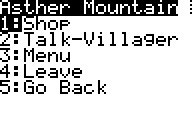
The menu in Asther Mountain.
When visiting locations, the player has a variety of options they can perform. Many locations have a shop where they can buy a set amount of HP potions with the gold acquired from battling. Shops can also be used to sell potions in exchange for gold, and by spending 10 gold, the player can fully restore their HP. Several locations also have different set pieces that advance the gameplay, and few locations also have a unique resident who speaks to the protagonist. Certain locations even allow the player to find a monster fight. Additionally, each location gives the player access to the menu, where they can perform several other actions, including using a potion, saving all of their progress to one of two files that can be loaded from the main menu, or quitting the game altogether. The player can also check their stats in the Status menu, including the protagonist name, HP, GP, level, experience points, amount of experience points needed to level up, attack power, gold, and each potion count.

The menu when fighting a dead hand.
The player occasionally battles monsters after leaving a location, or after looking for one to fight. Like the original game, the battles themselves are turn-based, in which the player has the option to either attack the monster or use a potion. Attacking will deal a certain amount of damage to the monster, who will then respond with an attack of their own to the player, ending the turn. The damage each attack deals depends on the protagonist's level, as higher levels deal more damage. Dealing enough damage to the monster will defeat it, ending the battle. Additionally, players can summon monsters in battle using their GP, and they can also check their stats.
Gallery[]
Trivia[]
- This game takes up a significant amount of memory on a calculator, so much so that it cannot be completed in a single run, as storing every file will overload the memory. Thus, after completing one of three parts of the game, the player is instructed to archive the part's game file to save space.
- To help avoid memory overloads and slower speeds during gameplay, the game features the option in the menu to collect "garbage" files.
- The "The End" cutscene at the end of the game was created by Gregory McLeod's friend Jonathan.
External link[]
| ||||||||||||||||
| ||||||||||||||||
